Note: I use male/female pronouns for wild animals even when I can't discern the sex. I don't like to depersonalize a living being as an "it." In this case, I did not know the sex of this gull.
In my previous post, I mentioned a Western Gull I managed to rescue … by true luck. Here's that story.
We were in Los Angeles all of January and part of February, and in the context of a chaotic month, I stole an hour to go strolling on the beach.
On my walk over through Redondo Beach, I saw two Black Phoebes (Sayornis nigricans), one who preferred automobile side mirrors as perches. She'd flutter down for an insect grab, then return to her station.
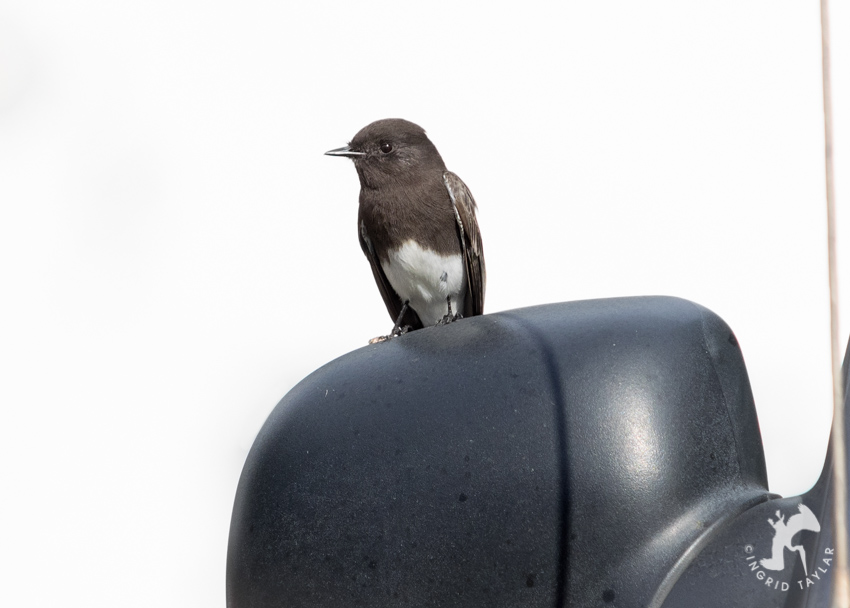
[Additional adjustments on this image: selective levels, spot cleanup]
The other phoebe preferred signs and posts.
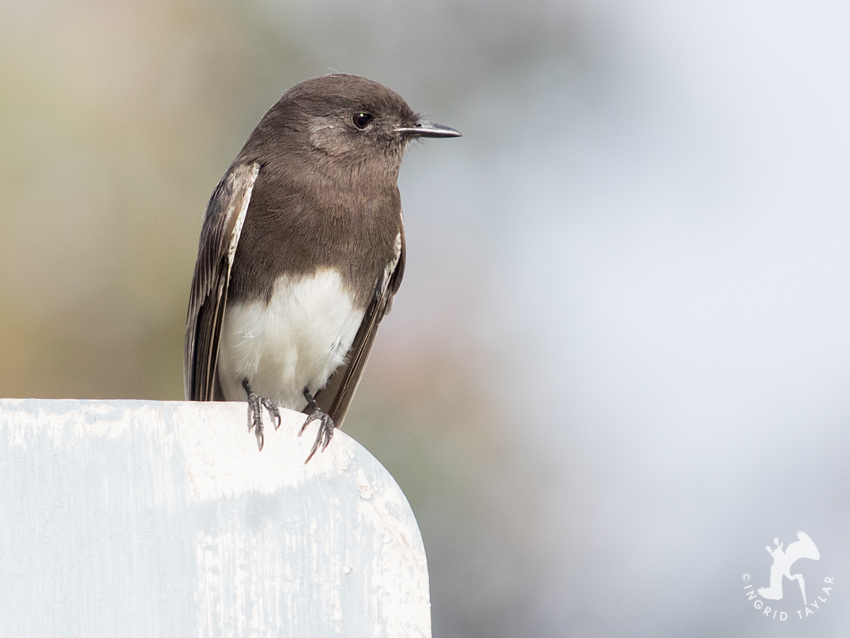
Black Phoebes love water environments so I wasn't surprised to see these two just blocks from the Pacific. Their methodology is to perch, as pictured here, then snatch their insect prey on the ground or from the air.
I left the phoebes to their business and hopped down some stairs to the sand — getting my first whiff of briny air and my first earful of the surf, tumbling on shore like crash cymbals. Home! Happy. I dropped to my belly to photograph a few of the Heermann's gulls, sitting zazen in their formal blacks and whites.
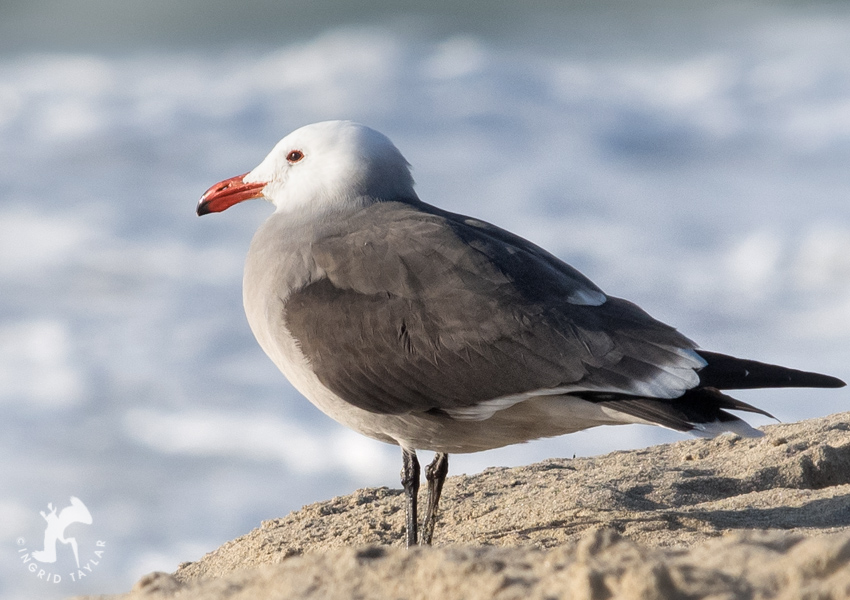
First Sighting … Problem Ahead
I scanned the flock to see which other gull species were loafing on the beach, and that's when I saw it … that thing I don't want to see but which I often encounter. It was an anomalous shape in my periphery, something clearly out of sorts. When you photograph the "normal," the eye gets trained to see the abnormal on the tableau. In this case, it was a gull, sitting away from his flock mates, lying neck deep in a sand divot. A Redondo Beach patrol vehicle passed within feet and the gull didn't even move.
I ran over to check on the bird. The truck tracks missed him by a tire's width or two. He looked bedraggled and ill, and I knew he needed help. But, capturing a bird like this, by myself, without rescue gear is always a challenge if he can run and fly. The only tools I had on me were my jacket and a pair of scissors I threw in my camera bag at the last minute … just in case. I almost always find fishing line on beaches and bring scissors to cut it up.
My plan was to slowly sidle up to the bird and see how close I could get, throw my jacket over him and quickly grab him in a body lock. As soon as I got within jacket-tossing distance though, he got up and moved just out of reach, eyeing me constantly, obviously not wanting me close. I didn't want to stress him, so I backed off to observe from a distance. After a few minutes, the gull decided to join his flock, skimming the sand in a compromised flight pattern.
As he stood on the high berm with his mates, I felt better that he was safe from beach patrol vehicles. I decided to stay close by to see if another chance at capture might present itself. I snapped this photo which revealed to me the problem: fishing monofilament, sadly, not a surprise in this fishing-intensive area and pier.
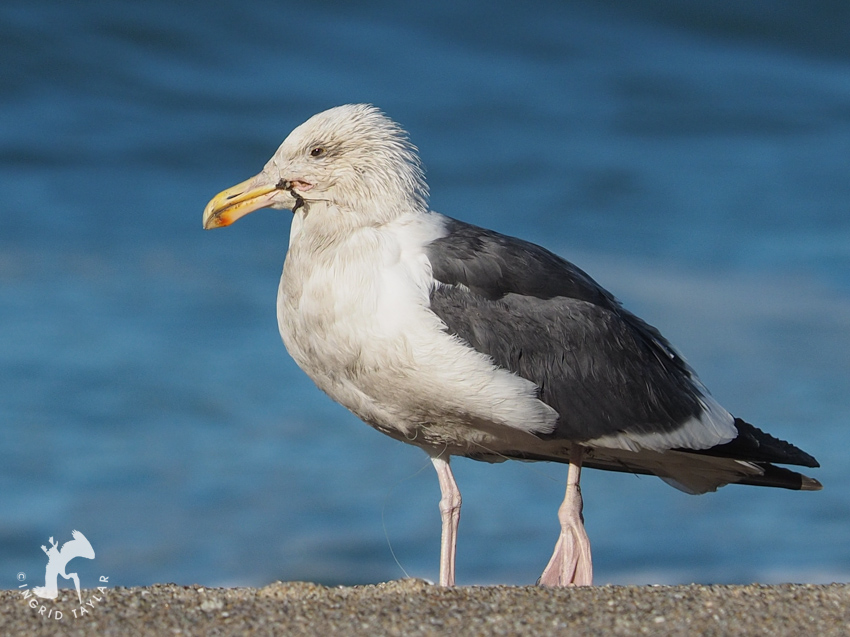
The fishing line was wrapped around the base of his bill and also trailing from his feet. It looked to be stuck under his wing, as well.
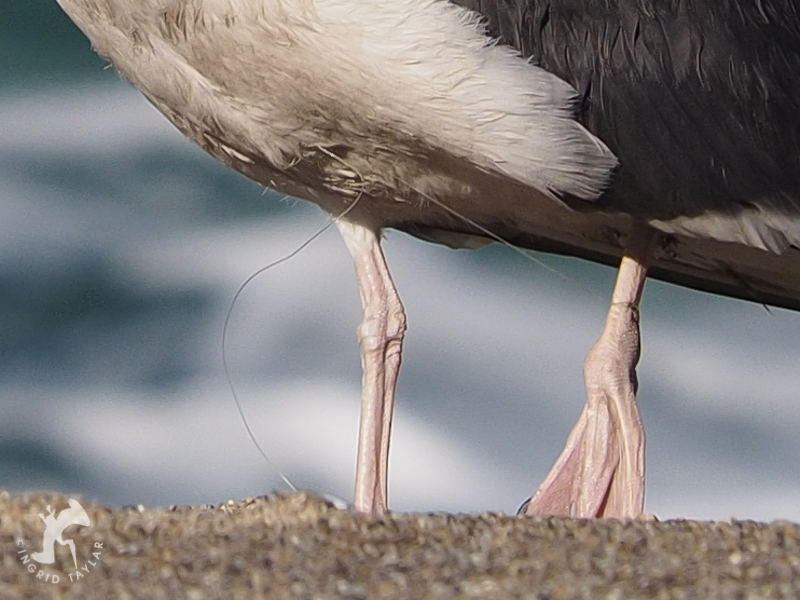
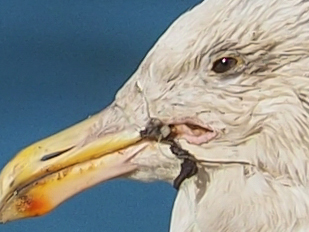
As the gull shut his eyes, resting, I turned away for just a moment to snap this shot of a Willet (Tringa semipalmata) skipping through the surf, hunting for crustaceans and worms.
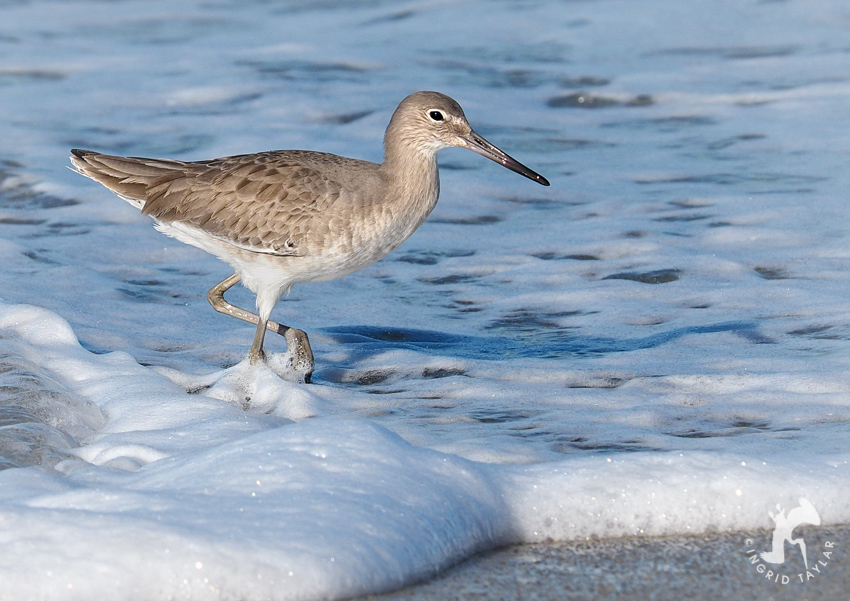
Gull in Trouble
It seemed like a mere instant that I looked away, but when I turned back I caught a near calamity out of the corner of my eye. A white shape was bobbing in the surf and I knew instantly it was him. He must have been taken out by a particularly big wave, and was so debilitated, he was bobbing in the water like a marionette.
I had no time to stash my camera, I just slung it on my back like a messenger bag and ran over to the location. It looked hopeless. I had just a split second to figure it out when, in a move I couldn't believe — one serendipitous gesture by nature — a huge wave pushed the gull back toward the beach. He was flattened against the sand and struggling as the undertow pulled him back. But, it was just enough time for me to grab him around the wings and tuck them against his side. As I did so, my camera swung around my back and it was just an instinctive block by my elbow that kept it from becoming a lethal device.
I emerged from the surf like the creature from the bog, me and the discombobulated gull, soaked, salty and sandy. I wandered over to the boardwalk and rested for a minute, pondering my next move. I was unprepared, except for the scissors in my bag which I couldn't reach without losing a grip on the gull.
The Gull's Personal Veterinarian
This gull must have had a guardian angel because just as we sat down, a woman came up, saw the situation. I asked if she'd ever cut monofilament off a bird before. She had. She was a veterinarian. She found my scissors and snapped the fishing line off the gull's bill first, then discovered that same line was also wrapped around his neck. At this point the poor bird regurgitated on me.
The vet next clipped the line around the gull's legs, discovering the worst part: a hook deeply embedded in his foot. From this hook the line twisted around his legs and then like a tourniquet around his wing joint. The wing was not broken or visibly damaged, thankfully. But she found another hook embedded underneath the wing. The next step was getting him to a wildlife rehab where the hooks could be removed with anesthetic.
We had several blocks to walk to my car, so this was our routine for the next many minutes, waiting at stoplights, gull reaching out to find another place to bite me. The bites don't hurt that much unless they get your face — an injury I was trained to avoid. I snapped this with my iPhone, the Western Gull tucked in my jacket having knocked the hood off once again.
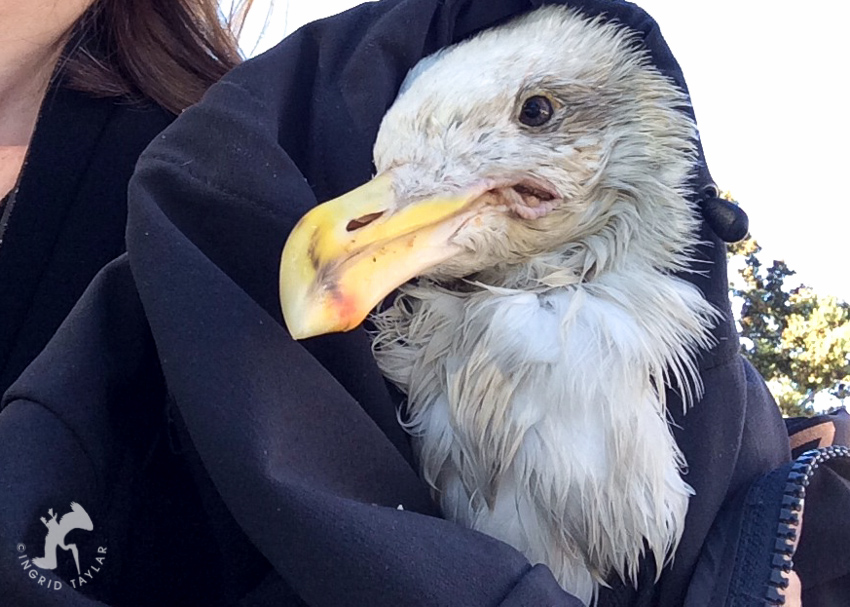
In another stroke of good fortune, International Bird Rescue had a hospital in San Pedro, about a half hour from where I was. They handle seabirds and gulls. So, after getting the gull into a carrier (I keep a portable one in my car), this Western Gull was finally on the road, literally, to healing. I was never so glad to be in the good hands of professional rehabilitators.
Support Wildlife Hospitals!
My wildlife skills have a serious limit, I was a part-time volunteer. So, like everyone else, I rely on the medical expertise of places like International Bird Rescue when situations like this arise. So often, wild animals go without this type of aid because there is nowhere to take them.
If you have a wildlife center near you, please consider donating. They rely on public support for these types of cases. When you see the effort that goes into rescuing or rehabilitating one small gull, it's monumental what these organizations accomplish across species, time and circumstance. If you don't have a wildlife rescue near you, you can make donations to facilities like International Bird Rescue or the Marine Mammal Center, among other organizations. Those are two of our west coast wildlife orgs. Their reach goes far beyond the local and into global disaster situations like oil spills.
——————————————-
On a related note …
My fellow blogger and colleague at the Wildlife Conservation Stamp Project, Larry Jordan, wrote a fantastic, illustrated piece on International Bird Rescue and the work they do. That piece is here:
Disclaimer: I have put in volunteer time at International Bird Rescue during a spill event, so I've had some personal affiliation.


I really enjoyed reading about how you handled this experience Ingrid. You really did a great job caring for the gull and I’m glad help showed up at the right moment.
Thank you. It’s a bit long, I realize, but whenever I right about a rescue, I figure the information might just help someone else assess whether or not to intervene in a similar situation.
Ah, happy endings! Keep ’em coming!
I suspect the gull sensed you were helping him, but was pecking you out of fear of the unknown and unfamiliar.
So grateful for your close observation, your immense caring, and your determined efforts to rescue him. Thank goodness, too, for the vet’s timely arrival and for the lightbulb moment when you remembered the bird rehab place.
Allow me to add: Though I don’t disagree with your dream world scenario of assigning a portion of all license, tag, and permit revenues to the establishment and maintenance of rescue facilities everywhere, my dream world finds the money to do that from other sources — say, a portion of the fees charged to visitors at national parks. Because in my peaceable kingdom (which just might be yours, too!), there is NO capturing and killing of animals, whether on land, in the air, or under the sea. I know, I know, I’m not sounding realistic, at least in the near-term. But dreams founded in compassion and justice for all DO have a way of coming true eventually! 🙂
CQ, thanks for the comment. I know — I should have been more grandiose in my dreaming — or at least toned down the word “dream” to “seeking some remediation in this slanted system.” My dream world, like yours, would eliminate violence toward animals and humans. My dream world is so far from reality that perhaps I couldn’t even conceive of a dream that transcended what seems to be the dream of simple accountability for animal injury. It’s sad and revealing how one’s standards can change, based on the baseline paradigm. And it’s a good reminder not to let that baseline be a measure for what might truly be possible.
As far as the gull sensing I was helping him, perhaps you’re right, but I think in some form of his higher self. Most wild animals want nothing to do with us, and I can’t blame them for that sentiment. And on rescues, I so wish that all such shapes turned out to be paper bags on the beach.
I do think that animals know and sense when a rescue is done. In this case Ingrid, you were the guardian angel. I am furious with the irresponsibility that anglers have demonstrated and I really cannot empathise with any of them. I have many times persuaded anglers to let their fish go with the argument that the fish they catch is too small to satisfy their hunger. Sometimes it works, and sometimes they send me to hell, but I at least I try. I’m against all types of fishing, as ancient a food source as it may be. People continue to think that lakes and oceans are bountiful sources of food “the Lord has given them”. This is how religion can be like a poison, but I don’t say this in offense to any individual’s spiritual teacher or leader.
There seems to be a religious notion that creates a fantasy world in which nature has a bountiful supply of food just for us. So hunters, as well as anglers are in “heaven” when claiming this gift from earth. They feel they literally have had a communion with the almighty after their day out hunting and fishing.
Maria, I just had a contentious discussion at another blog where the hunter and commenters infused personal spirituality into the idea of killing. It’s difficult for a non-hunter like myself to equate the forceful taking of a life with the ‘spiritual.’
Wow, well I hope the gull is ok and back on the water again?
Phil, I hope so, too. International Bird Rescue didn’t do an intake number on him so I can just hope they removed the hooks and released him after a short rehab.
Ingrid, such a compelling story! Of course you saw this little guy and helped him out! How many others didn’t even notice? The things we see when attuned are breathtaking in their beauty and sadness. When I found an injured juvenile in a parking lot here in Seattle the outcome was much less promising; he died in my jacket, on the way to the car, where we would have headed to PAWS in Lynwood. It saddened and angered me to know how many people ignored his plight, but being with him and keeping him sheltered in his final moments was an incredible privilege. You are a true wonder of nature, Ingrid!
Louise, thank you for this incredibly kind sentiment. I relate deeply to the feelings you had about the injured juvie. Last year seemed like a record-breaking one at this end in terms of the injured birds I found but who subsequently died before I could get them help. I started to dread leaving the house. And, similar to your experience, in almost all cases, most people showed no concern, sometimes not even stopping when animals were in the middle of the road. It can be exasperating but I realize all we can control is our own reaction to those situations. Your comment reminds me that it’s up to those of us who do notice to at least provide some comfort even if it means a few minutes before they pass on. To provide sanctuary, even in a jacket, from the trauma of a parking lot or road is sometimes the best we can do. 🙁